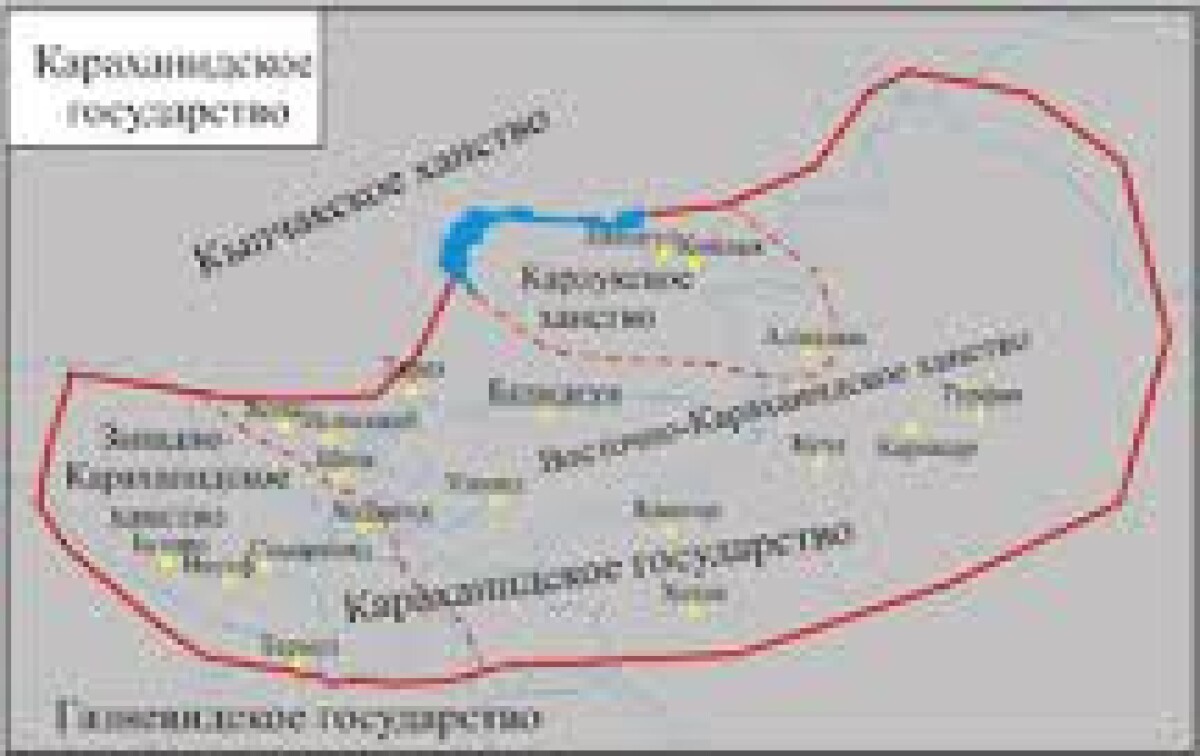
It is considered that the founder of the Karakhadids
was SatukBughra Khan (915-955). Supported by the Samanids he marched against
his uncle Ogulchak and conquered Kashgar and Taraz. In 942 Satukoverthrew the ruler
of Balasagun and declared himselfthe Khagan.From this time starts the history
of the Kara-Khanid Khanate.
The main role in the formation and early history of the Karakhanidswas played by the Karluktribes, which included the Chigils and Yagmas. In the 10th century part of Yagmas with Karluks lived in Semirechye, in the southof Naryn. Later, in the 11th centurythe Yagmas lived much further north - in the Ili valley. In this same valley the Chigilssettled moved from northern Issyk-Kul region.
In 992, the Karakhanids conqueredKhotan on the east and Bukhara on the west. In 999 Nasr Karakhanid and ruler of the Ghaznavid dynasty Mahmud finally crushed the Samanid Empire in Central Asia. The Amu Daryabecame the borderland between the Karakhanids and Ghaznavids. In the north the boundary between the Karakhanidsand the Kipchak Khanate passed not far from Taraz. In the north-east the Karakhanid’spossessions were limited by the line of Balkhash and Alakol Lakes. In the east they bordered with the Uyghurs, in the southeast their territory extended to theCherchen. In the west and south-west the movement was met with resistance of the Seljuks(South Turkmenistan) and Khorezmshahs (in the downstream of the Amu Darya). During the next two centuries the possession of Karakhanids extendedfrom Transoxiana (between the Amu Darya and Syr Darya Rivers) in the west to the Semirechyeand Kashgar in the east.
The Kara-Khanid Khanate was divided into numerous appanages with unstable boundaries. The rulers even had the rights of minting coins with their names, sometimes with the changing titles. Political life was full ofinternal warfare and struggle.
In the 30's of the 11th century the Kara-Khanid state ruled by Ibrahim ibn Nasr broke up into two parts: the Western Khanate centered at Bukhara, which included the territory from Transoxiana to Khujand and the Eastern Khanate, which included Taraz, Isfidzhab, Shash, Ferghana, Semirechye and Kashgar. The capital of the Eastern Khanate was Balasagun. The Karakhanid state formally separated into independent and semi-independent appanages, ruled by the single Khan before.
In 1056 a son of Qadeer Khan,Yinal-tegin,in fight for inheritance conquered the possessions of his brother Suleiman, but soon was poisoned. The son of Yinal-tegin, Ibrahim,ascended the throne, but soon died in the war with the Barskhan ruler. After that in the Eastern Khanate for fifteen years (1059-1074) ruled the sons of Qadeer Khan, Yusuf Toghrul Khan and BughraKhanHarun. Under their rule Fergana fell into realm of the Eastern Khanate, and the border between two Khanates passed along the Syr Darya River. After the death of Toghrulhis domains were inherited by Bughra Khan Harun (1075-1102), the ruler of Kashgar, Khotan and Balasagun. In 1089 he became a vassal of the Seljuk Sultan Malik Shah. In 1102 soon after the death of Bughra Khan the ruler of Tarazand Balasagun,Qadeer Khan Zhabrail, attackedTransoxiana. He captured the land up to the Amu Darya, tried to take control of Seljuk town Termez, but was defeated, captured and executed.
Under the rule of mighty Sanjar Sultan (1118-1157) the Seldjuks achieved big influence in Transoxiana. During this period, there has been political decline of the Karakhanids.
In the 12th century the Kara Khitans occupiedSemirechye and Balasagun, then the rest of the Eastern Khanate possessions and began to move to the Western Khanate. After the Karakhanid and Seljuk troops were defeated in 1141, the political power over the both Karakhanid Khanates moved to the Kara Khitans. In 1212 Muhammad Khorezm Shah killed the last Western Khagan Osman from Samarkand. History of the powerful Karakhanid Khanate was over.
The Karakhanid state was different from the previous states. In contrast to the political structure of the nomadic societies in Kazakhstan the military and administrative control were separated from each other. Public administration structure was based on the hierarchical principle.
The Khans gave to their relatives the right to receive taxes from the population of the district, region or city. Such administrative grant was named "Iqta‘" and its holder called mukta, or iqtadar. The Iqta‘system played an important role in the economic and political life of the south and south-east of Kazakhstan.
The population made their living first of all raising livestock. However, in the 11-12th centuriessome Turkic tribes in Semirechyeand in southern Kazakhstan passed to farming and started to live in the cities.
Ancient Turkicreligious beliefs tookan important place in the ideology of the nomadic and sedentary populations. In the middle of the 10th century the Karakhanids converted to Islam, which was adopted as the state religion. Islamization, especially of the southern regions of Kazakhstan, the spread of Islam in the nomadic aristocratic environment led to the displacing of the ancient Turkic runic writing and the formation of new Turkic writing in Arabic script.
Islamic literature in the Turkic language appeared. The most famous writers were YusufBalasaguniand Mahmud al-Kashgari.
Kara-Khanid legacy is the most enduring cultural heritage among coexisting cultures in Central Asia from the 9th to the 13th century. Only the period of Mongol invasions interrupted the natural process of development.
